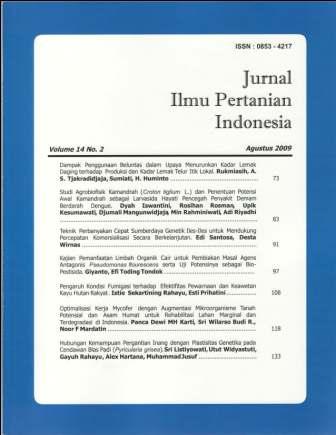Teknik Perbanyakan Cepat Sumberdaya Genetik Iles-Iles Untuk Mendukung Percepatan Komersialisasi Secara Berkelanjutan
Abstract
Increasing demand on glucomannan as healthy diet in develop countries, promotes higher planting area of Amorphophallus. Iles-iles corm (Amorphophallus muellen) contains high percentage of glucomannan. In order to meet with increasing demand, providing mass planting materials is a great concern in Indonesia. Therefore, the study on skin corm and bulbil as propagation materials was conducted. In the first experiment, bulbil with different size and section, i.e., very small, small, medium and large, and half section and 1f4 section were used. In the second experiment, we evaluated the prospect of skin corm as propagul where different size of skin corm was used, i.e., 1 em x 1 em, 2 em x 2 em, and 4 em x 4 em. Results showed that both bulbil and skin corm could be utilized as prospectivepropagules of iles-iles. Propagation using bulbil was more superior as compared to skin corm. Bulbil of both whole and sectioned had high emergence of bud (> 90%), except very small sized ones. Very small bulbil (diameter less than 1 em) resulted in ca 605 of emergence. Skin corm sized 4 em x 4 em produced equal emergence to medium bulbil. In general, increasing size of skin corm increased success of emergent bud. Delaying emergence on small sized skin corm could be assessed by smaller nutrient reserved. Most unseccessemergence of small sized skin and very small bulbil was due to decay of the propagules. These experiments implied that both bulbils and skin corm could be used as mass propagules for iles-iles production.
Downloads
References
Das, P.K., H. Sen, N.C. Banerjee and P.K. Panda. 1997. Growth analysis and dry matter partitioning of elephant foot yam (Amorphophallus paeoniifolius) under different plant densities and sett sizes. Ind. J. Agric. Sci. 67 (5):197-200
Hetterscheid, W. and S. Ittenbach. 1996. Everything you always wanted to know about Amorphophallus, but were afraid to stick your nose into. Aroideana 19: 7-131.
Jansen, P.C.M., C. van der Wilk, and W.L.A. Hetterscheid. 1996. Amorphophallus Blume ex Decaisne. In M. Flach and F. Rumawas (Eds.). PROSEA 9: Plant yielding non-seed carbohydrates. Backhuys Publ. Leiden. p45-50.
Miura, K., and K. Watanabe. 1985. Effect of seed-corm age and weight on the efficiency of corm tuberization in konjak plants (Amorphophallus konjac). Jpn. J. Crop Sci. 54(1): 1-7 (in Japanese with English summary)
Ohtsuki, T. 1968. Studies on reserve carbohydrates of four Amorphophallus species, with special reference to mannan. Bot. Mag. Tokyo 81:119-126.
Santosa, E. 2006. Study on edible Amorphophallus species in Indonesia. Thesis. The University of Tokyo, Japan. 200 p.
Santosa, E. and Nobuo Sugiyama. 2007. Growth and production of Amorphophallus paeoniifolius Dennst. Nicolson from different corm weights. Bulletin Agronomy 35 (3): 23-35
Santosa, E., N. Sugiyama, A.P. Lontoh, Sutoro, S. Hikosaka, and S. Kawabata. 2002. Cultivation of Amorphophallus paeoniifolius Dennst.) Nicolson in home garden in Java. Japanese Journal of Tropical Agriculture 46 (2):94-99
Santosa, E., N. Sugiyama, E. Sulistyono and D. Sopandie. 2004a. Effect of watering frequency on the growth of elephant foot yams. Jpn. J. Trop. Agric. 48 (4): 235-239
Santosa, E., N. Sugiyama, M. Nakata and O. N. Lee. 2006. Growth and corm production of Amorphophallus at different shading levels in Indonesia. Jpn. J. Trop. Agric.50 (2): 87-91 (June)
Santosa, E., N. Sugiyama, M. Nakata and O. N. Lee. 2006a. Effect of use of different seed corms regions as planting materials on the growth and yield of elephan foot yam. Jpn. J. Trop. Agric. 50 (3):116-120 (September)
Santosa, E., N. Sugiyama, O. N. Lee and M. Nakata. 2006. Arrangement of cormels on the corms of edible Amorphophallus in Indonesia. Jpn. J. Trop. Agric. 50(2):92-94 (June)
Santosa, E., N. Sugiyama, S. Hikosaka and S. Kawabata. 2003. Cultivation of Amorphophallus muelleri Blume in timber forests of east Java. Jpn. J. Trop. Agric. 47 (3):190-197
Sen, H., P.K. Das and D.B. Goswami. 1996. Growth and corm production of elephant foot yam as affected by seed corm size, type, NK nutrition and harvesting date and evaluation of the low cost storage methods. In G.T. Kurup, M.S. Palaniswami, V.P. Potty, G. Padmaja, S. Kabeerathumma and S.V. Pillai (eds.) Tropical Tuber Crops: Problems, Prospects and Future Strategies. Sci. Publ., USA). p298-305..
This journal is published under the terms of the Creative Commons Attribution-NonCommercial 4.0 International License. Authors who publish with this journal agree to the following terms: Authors retain copyright and grant the journal right of first publication with the work simultaneously licensed under a Creative Commons Attribution-NonCommercial 4.0 International License. Attribution — You must give appropriate credit, provide a link to the license, and indicate if changes were made. You may do so in any reasonable manner, but not in any way that suggests the licensor endorses you or your use. NonCommercial — You may not use the material for commercial purposes.


















